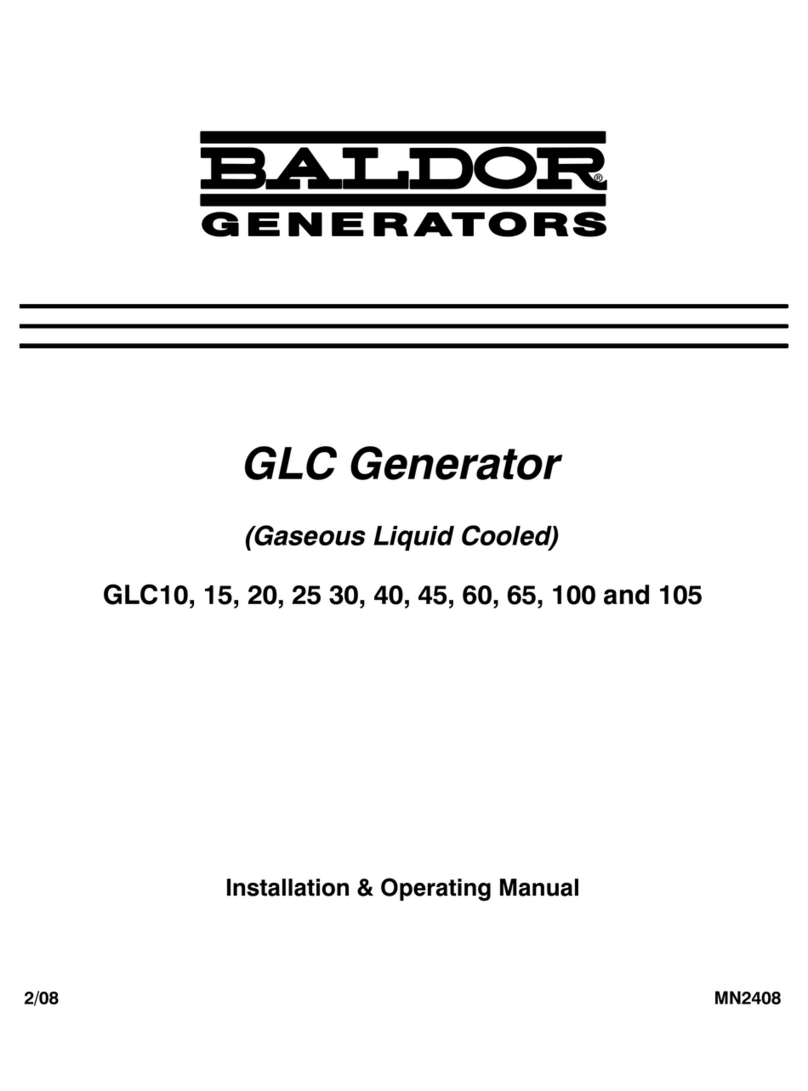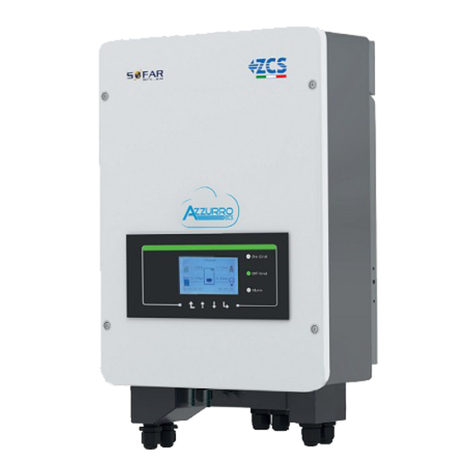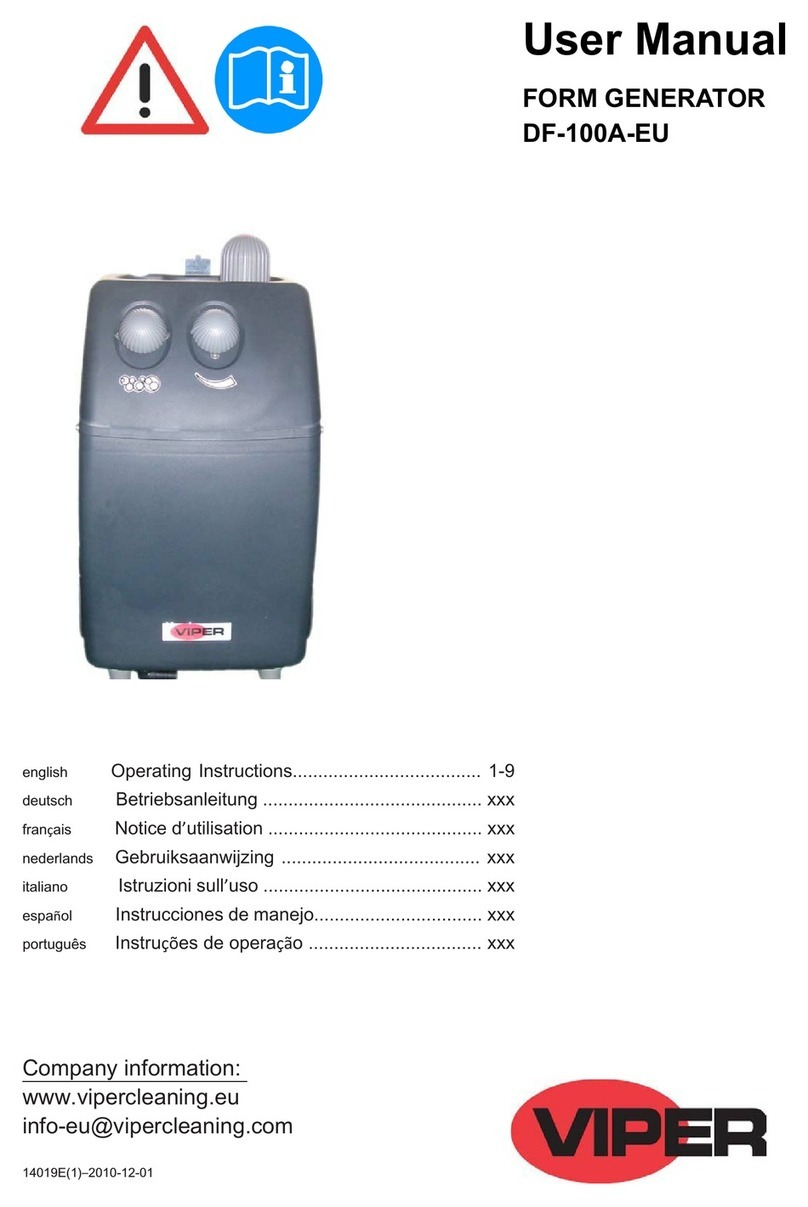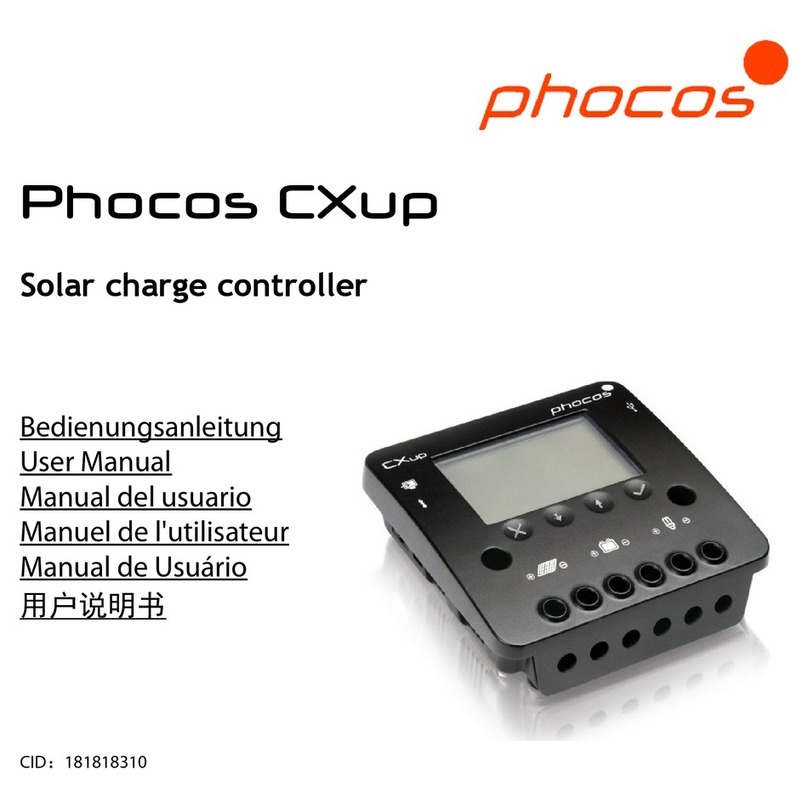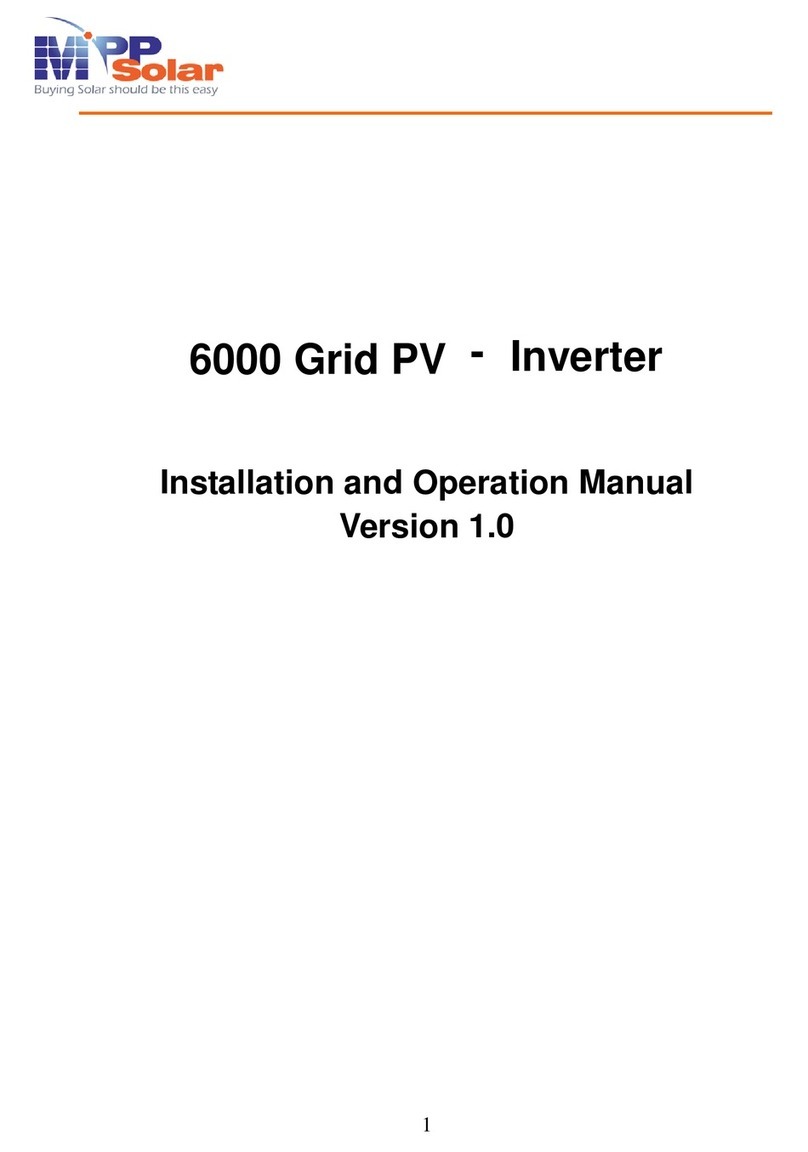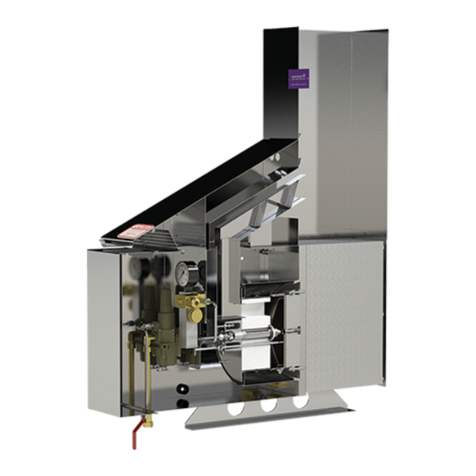INSBUD IB-INV-CSI User manual

POWER INVERTER
IB-INV-CSI; IB-INV-SSI
pure sinewave witch AC charger and MPPT
charge controller for photovoltaic systems

THIS PRODUCT HAS THE MARK
AND HAS BEEN MANUFACTURED IN ACCORDANCE WITH ISO 9001 STANDARD
INSBUD ul. Niepodległości 16a
32-300 Olkusz
Polska
+48 503 166 906
e-mail: [email protected]
The manufacturer promotes development policy. The right to make changes and
improvements to products and instructions without prior notice is reserved!
The contents of this manual - texts and graphics are the property of the manufacturer or its
subcontractors and are protected by law.
manual version: 1.0.0
rmware version: 1.0.0

IB-INV-CSI; IB-INV-SSI
1 General information ................................... 4
2 Scope of delivery ..................................... 4
3 Technical data ...................................... 5
4 Overview .......................................... 10
5 Possible congurations of batteries ......................... 15
6 Functional diagrams of charger/MPPT-solar charge controller ........ 16
7 Safety features ...................................... 19
8 Self error correction ................................... 21
9 Warranty terms and conditions ............................ 22

WWW.INSBUD.NET
1General information
The IB-INV-CSI; IB-INV-SSI inverter is
a technical device to invert DC voltage into
sinusoidal alternating voltage. DC voltage is
usually provided by a battery or powerwall.
The inverter inverts direct current (DC) into
alternating current (AC). 230V AC power
supply from the inverter allows to power the
devices regardless of the availability of the
domestic power supply (shore power).
With the integrated IUoU charger of the
inverter IB-INV-CSI series, there is the
possibility to recharge the discharged batte-
ries or powerwall.
The IB-INV-SSI series inverters, in ad-
dition to the integrated IUoU charger, are
equipped also with the MPTT charge con-
troller for photovoltaic systems.
ECO Mode: Only solar power is used to char-
ge the batteries. Only solar power is used to
supply the 230V consumers (inverter func-
tion witch MPPT-solar charge controller). If
solar power is not available, 230V consumers
are supplied from the battery (inverter func-
tion).
2Scope of delivery
1x Inverter
1x User Manual
4

WWW.INSBUD.NET
3Technical data
Model
Continuous
output
Battery
voltage
Idle current
consumption
AC charger
Dimensions
(LxWxH)
mm
Weight
kg
IB-INV-CSI-3-12V 300 W 12V DC 0,65 A 10 A 270x150x55 2,1
IB-INV-CSI-3-24V 300 W 24V DC 0,33 A 5 A 270x150x55 2,1
IB-INV-CSI-5-12V 500 W 12V DC 0,65 A 10 A 355x150x75 3,0
IB-INV-CSI-5-24V 500 W 24V DC 0,33 A 5 A 355x150x75 3,0
IB-INV-CSI-10-12V 1000 W 12V DC 0,65 A 10 A 430x150x75 3,7
IB-INV-CSI-10-24V 1000 W 24V DC 0,33 A 5 A 430x150x75 3,7
IB-INV-CSI-10-48V 1000 W 48V DC 0,17 A 5 A 430x150x75 3,7
IB-INV-CSI-15-12V 1500 W 12V DC 0,65 A 20 A 450x220x90 5,3
IB-INV-CSI-15-24V 1500 W 24V DC 0,33 A 10 A 450x220x90 5,3
IB-INV-CSI-15-48V 1500 W 48V DC 0,17 A 5 A 450x220x90 5,3
IB-INV-CSI-20-12V 2000 W 12V DC 0,98 A 20 A 480x220x90 6,5
IB-INV-CSI-20-24V 2000 W 24V DC 0,50 A 10 A 480x220x90 6,5
IB-INV-CSI-20-48V 2000 W 48V DC 0,25 A 5 A 480x220x90 6,5
IB-INV-CSI-25-12V 2500 W 12V DC 1,0 A 20 A 530x220x90 7,3
IB-INV-CSI-25-24V 2500 W 24V DC 0,50 A 10 A 530x220x90 7,3
IB-INV-CSI-25-48V 2500 W 48V DC 0,25 A 5 A 530x220x90 7,3
IB-INV-CSI-30-12V 3000 W 12V DC 1,2 A 20 A 480x220x150 9,5
IB-INV-CSI-30-24V 3000 W 24V DC 0,60 A 10 A 480x220x150 9,5
IB-INV-CSI-30-48V 3000 W 48V DC 0,30 A 5 A 480x220x150 9,5
IB-INV-CSI-40-12V 4000 W 12V DC 1,2 A 20 A 480x220x150 11,5
IB-INV-CSI-40-24V 4000 W 24V DC 0,6 A 10 A 480x220x150 11,5
IB-INV-CSI-40-48V 4000 W 48V DC 0,30 A 5 A 480x220x150 11,5
IB-INV-SSI-10-12V 1000 W 12V DC 0,5 A 20 A 380x220x150 5,5
IB-INV-SSI-10-24V 1000 W 24V DC 0,25 A 10 A 380x220x150 5,5
IB-INV-SSI-10-48V 1000 W 48V DC 0,13 A 5 A 380x220x150 5,5
IB-INV-SSI-15-12V 1500 W 12V DC 0,5 A 20 A 450x220x150 6,5
IB-INV-SSI-15-24V 1500 W 24V DC 0,25 A 10 A 450x220x150 6,5
IB-INV-SSI-15-48V 1500 W 48V DC 0,13 A 5 A 450x220x150 6,5
IB-INV-SSI-20-12V 2000 W 12V DC 0,65 A 20 A 500x220x150 8,5
IB-INV-SSI-20-24V 2000 W 24V DC 0,32 A 10 A 500x220x150 8,5
IB-INV-SSI-20-48V 2000 W 48V DC 0,16 A 5 A 500x220x150 8,5
IB-INV-SSI-25-12V 2500 W 12V DC 1,0 A 20 A 520x220x150 9,0
IB-INV-SSI-25-24V 2500 W 24V DC 0,5 A 10 A 520x220x150 9,0
IB-INV-SSI-25-48V 2500 W 48V DC 0,25 A 5 A 520x220x150 9,0
IB-INV-SSI-30-12V 3000 W 12V DC 1,2 A 20 A 500x220x150 10,5
IB-INV-SSI-30-24V 3000 W 24V DC 0,6 A 10 A 500x220x150 10,5
IB-INV-SSI-30-48V 3000 W 48V DC 0,30 A 5 A 500x220x150 10,5
5

WWW.INSBUD.NET
Surge power proportional to the continuous
output
120% – 150% for 10 seconds
150% – 200% for 2 seconds
Switching time UPS <16 ms
output AC voltage 230V
AC voltage uctuation: max. 10%
Frequency: 50 Hz ± 1Hz
Waveform Pure sine wave (THD < 4%) at rated input
voltage
Battery types Wet, AGM, GEL, LiFePO4(only with BMS)
Operating temperature −15 ÷40◦C
Storage temperature −40 ÷85◦C
Relative humidity 20% ÷90%
Eciency range (The eciencies depend on
the type of consumer devices and load. For
example, the inverter typically has the highest
eciency at a load of approx. 70%.)
12V: 86% – 92%
24V: 87% - 93%
48V: 88% - 94%
Operating performance MPPT-charge controller (IB-INV-SSI)
Battery voltage 12V 24V 48V
Charge eciency > 97% > 97% > 97%
Solar input voltage 15 - 70V > 24 - 70V > 48 - 70V
Max. output current 20 A 20 A 20 A
6

WWW.INSBUD.NET
Recommended battery cables and battery capacity:
Model
Number of sets
Recommended
thickness at
100cm
Recommended
thickness at
150cm
Recommended
thickness at
200cm
Recommended
thickness at
200cm
Battery capacity
(Wet, Gel,
AGM)
Battery capacity
(LiFePO4)
3-12V 1 4 mm26 mm210 mm216 mm2≥50Ah ≥25Ah
3-24V 1 2.5 mm24 mm26 mm210 mm2≥25Ah ≥12Ah
5-12V 1 6 mm210 mm216 mm225 mm2≥100Ah ≥50Ah
5-24V 1 4 mm26 mm210 mm216 mm2≥50Ah ≥25Ah
10-12V 1 16 mm225 mm235 mm250 mm2≥160Ah ≥90Ah
10-24V 1 6 mm210 mm216 mm225 mm2≥80Ah ≥50Ah
10-48V 2 6 mm210 mm216 mm225 mm2≥25Ah ≥25Ah
15-12V 2 10 mm216 mm235 mm250 mm2≥250Ah ≥100Ah
15-24V 2 6 mm210 mm216 mm225 mm2≥120Ah ≥70Ah
15-48V 2 6 mm210 mm216 mm225 mm2≥80Ah ≥35Ah
20-12V 2 16 mm225 mm250 mm250 mm2≥320Ah ≥180Ah
20-24V 2 10 mm216 mm225 mm235 mm2≥160Ah ≥90Ah
20-48V 2 10 mm216 mm225 mm235 mm2≥80Ah ≥50Ah
25-12V 2 25 mm235 mm250 mm250 mm2≥400Ah ≥200Ah
25-24V 2 10 mm216 mm225 mm235 mm2≥200Ah ≥100Ah
25-48V 2 10 mm216 mm225 mm235 mm2≥100Ah ≥50Ah
30-12V 2 25 mm235 mm250 mm250 mm2≥480Ah ≥250Ah
30-24V 2 10 mm216 mm225 mm235 mm2≥240Ah ≥125Ah
30-48V 2 10 mm216 mm225 mm235 mm2≥120Ah ≥70Ah
Cables and batteries are not included!
Please note the capacity! An under-
run of the recommended battery capa-
city can cause a loss of performance or
serious use restrictions as a result of vol-
tage drops.
Please respect a sucient ventila-
tion! The inverter produces heat loss.
The device is equipped with a thermal
overload protection. An insucient ven-
tilation can aect the function of the in-
verter, because the inverter can shut it-
self down for safety reasons. Please fol-
low the appropriate installation advice
below.
The inverter should not be used in ve-
hicles, in which the +pole is connected
to the chassis!
Please mind the input voltage! The
inverter should only be connected to vol-
tage sources which correspond to techni-
cal data. If connected to a higher volta-
ge source the fuse can immediately blow
and damage the inverter.
Please note the maximum power of
the consumer devices! For currents
>15 A consumer devices have to be con-
7

WWW.INSBUD.NET
nected directly to the terminal for direct
connections.
Idle current consumption! When the
inverter is not in use, turn it o with
the main switch. Otherwise, idle current
consumption will take place according
to this table and deep discharge may da-
mage your battery (if there is no BMS).
Please mind the starting current!
Keep in mind that inductive devices
(for example power drills or refrigera-
tors etc.) often need a 3–10 times higher
power at the beginning than indicated
on the descriptive type plate. The ma-
ximum power of this short period should
not surpass the maximum surge power
of the inverter.
Note the acoustic signal! In case of
overload an acoustic signal will sound. If
the consumer devices power is not redu-
ced to the maximal continuous output,
the inverter will shut down automatical-
ly.
Output power losses because of he-
at. An ambient temperature over 40°C
(for ex. due to heat at the installation si-
te or direct sunlight) can lower the spe-
cied output and eciency.
Restrictions on Use. The following
persons should use this product only un-
der the supervision of another responsi-
ble person:
Persons with limited physical apti-
tude.
Persons with limited mental apti-
tude.
Persons with limited sensory apti-
tude.
Use the device only in accordance with
its designated use.
Store the device out of the reach of chil-
dren.
When the inverter isn’t in use for longer
periods of time, please follow this advice
to protect your battery from discharge:
Disconnect all consumers from the
inverter.
Disconnect the battery from the
inverter by using a disconnector or
by disconnecting the cables.
If the battery isn’t completely di-
sconnected, a minimal current con-
sumption by the inverter will con-
tinue to take place.
If two sets of battery cables are recom-
mended, both sets with an appropriate
cable thickness must be installed. Failu-
re to do so can easily lead to overheating
of the overloaded cables and connection
points and cause a dangerous cable re.
The IB-INV-CSI inverter are general-
ly build for so called „O-Grid”-Systems
and should only be used autonomously.
Do not connect the inverter output (soc-
ket) with an other voltage source. Di-
sregarding this advice is life threatening
and will destroy the inverter immedia-
tely.
Risk of electric shocks! The device is
equipped with security features to pre-
vent dangerous electric shocks. Howe-
ver, in order to ensure the highest possi-
ble safety during operation, it is impe-
rative that the inverter’s ground connec-
tion be connected to a protective earth
in any case.
Maintenance and repairs may only be
performed by properly trained person-
nel.
8

WWW.INSBUD.NET
The installation of this equipment may
only be performed by trained and autho-
rized personnel and in compliance with
all applicable safety regulations and gu-
idelines.
Especially when used on a boat an in-
correct installation can lead to corrosion
damage. Therefore the installation sho-
uld be performed by trained boat elec-
tricians.
Important mounting instructions!
To reduce the risk of re, injuries and
electronic shocks, please note the follo-
wing instructions:
The device can be installed hori-
zontally or vertically.
Do not cover the ventilation slits
and ensure adequate ventilation.
The installation site of the inver-
ter has to be well ventilated.
Install the inverter only on solid
mounting surfaces.
Do not pull the cable.
Do not install near heat sources or
in direct sunlight.
Avoid dust, humidity and amma-
ble or caustic substances near the
inverter.
The inverter heats up during
operation, keep away from heat-
sensitive materials.
Do not drop the inverter and avoid
shocks.
Do not place any objects on top of
the inverter.
Do not open the device.
Only use dry wipes or compressed
air for cleaning. Switch o the in-
verter before cleaning.
Switch of the inverter before all
kinds of work.
The damaged inverter should be
taken out of service.
9

WWW.INSBUD.NET
Front view: IB-INV-CSI-5 and IB-INV-CSI-10
1- Switch ECO/OFF/UPS
2- LED „Power”
3- LED „Fault”
4- LED „Charge”
5- LED „AC-In”
6- LED „By-Pass”
7- Remote control port
8- USB-port
9- Shore power
10 - Fuse
11 - Protective earthing
12 - 230V consumer devices power soc-
ket
Front view: IB-INV-CSI-15,IB-INV-CSI-20 and IB-INV-CSI-25
1- Switch ECO/OFF/UPS
2- LED „Power”
3- LED „Fault”
4- LED „Charge”
5- LED „AC-In”
6- LED „By-Pass”
7- Remote control port
8- USB-port
9- Shore power
10 - Protective earthing
11 - Fuse
12 - 230V consumer devices power soc-
ket
12

WWW.INSBUD.NET
Front view: IB-INV-CSI-30
1- Switch ECO/OFF/UPS
2- LED „Power”
3- LED „Fault”
4- LED „Charge”
5- LED „AC-In”
6- LED „By-Pass”
7- Remote control port
8- USB-port
9- Shore power
10 - Protective earthing
11 - 230V consumer devices power soc-
ket
Terminal for direct connection (IB-INV-CSI-30 and IB-INV-SSI series):
AC Output AC Input
13

WWW.INSBUD.NET
Front view: IB-INV-SSI-10 to IB-INV-SSI-30
1- Switch ECO/OFF/UPS
2- LED „Power”
3- LED „Solar”
4- LED „Fault”
5- LED „Charge”
6- LED „AC-In”
7- LED „By-Pass”
8- Remote control port
9- USB-port
10 - Shore power
11 - Protective earthing
12 - MC4 Solar Connection
13 - 230V consumer devices power socket
14

WWW.INSBUD.NET
5Possible congura-
tions of batteries
If several batteries are used, there are vario-
us conguration possibilities of the battery
banks depending on the inverter model (12V,
24V, 48V).
Series connection (serial): voltages add
up, capacity remains unchanged.
Parallel connection (parallel): capaci-
ties add up, voltage remains unchan-
ged.
Series and parallel connection (serial
and parallel): capacities and voltages
add up.
Examples:
SERIES
Voltage: 12V + 12V + 12V + 12V = 48V; Amp Hours remain at 200
PARALLEL
Voltage remains at 12V; Ah: 200 Ah + 200 Ah + 200 Ah + 200 Ah = 800 Ah
SERIES/PARALLEL
Two strings of batteries in series are connected in parallel.
The voltage increases to 48V and the amp hours increase to 400 Ah.
15

WWW.INSBUD.NET
6Functional diagrams
of charger/MPPT-
solar charge control-
ler
The inverter is able to charge batteries and
supply consumer devices with electricity
when shore or solar power is available as
below:
Device switched on in ECO Mode (pure in-
verter mode):
Only solar power is used to charge the
batteries.
Only solar power is used to supply
the 230V consumers (inverter function
witch MPPT-solar charge controller).
If solar power is not available, 230V
consumers are supplied from the bat-
tery (inverter function).
Device switched on in UPS mode (uninter-
ruptible power supply):
Solar power is primarily used to charge
the batteries.
Shore power is primarily used to supply
230V consumers(by-pass function).
If solar power is disconnected, the sys-
tem switches from solar to AC char-
ging via shore power after approx. 30
seconds if battery needs charging.
If shore power is not available, 230V
consumers are supplied from the bat-
tery (inverter function).
Device switched o:
Simultaneous charging with solar and
shore power possible (like scenario 5,
see section UPS Mode)
Shore power can be used to supply the
230V consumers (by-pass function).
Battery is not used to supply 230V con-
sumers.
Explanation of charging phases IB-INV-
CSI and IB-INV-SSI series. All voltage
values refer to 12V. For 24V double value.
For 48V 4x value. The voltage tolerance is
±0.2V.
The integrated charger as well as the MPPT-
solar charge controller of the IB-INV-SSI
charge battery automatically with a 3-step
IUoU charge characteristic which is descri-
bed below.
Bulk (main charge): The battery is
charged with permanent current and
carefully rising voltage until a prede-
ned maximum voltage and until a stage
of charging of 80% is reached.
Absorption (remaining charge):
The battery is charged with permanent
current and gradual decreasing current
from 80% to 100% capacity. The gradu-
al decreasing current ensures that the
terminal voltage does not become too
high during the complete charging pro-
cess.
FLOAT (charge maintenance): The
battery status remains permanently at
13,6V without overcharging or dama-
ging the battery. The voltage is perma-
nently controlled in this mode. If the
voltage decreases to a predened level,
the battery is charged through a pul-
se charge until reaching again 100%, so
the charge status remains permanently
between 95% and 100%. This charging-
cycle is repeated appropriately and in-
uences the lifetime of the battery in
a positive way.
16

WWW.INSBUD.NET
If the inverter is switched o, the batteries
will be charged by shore power or solar po-
wer.
ECO mode:
If the inverter ECO function is activated, the
batteries will not be charged by shore power.
UPS Mode:
Scenario 1: Shore power available du-
ring daytime
T0 – T5: (by-pass function)
If shore power is available, the by-pass func-
tion starts automatically, the inverter func-
tion is deactivated and all devices are sup-
plied with shore power. As long as the batte-
ry voltage is >11V the shore charger remains
deactivated in this phase.
The solar power charges the batteries with
a IUoU charging characteristic (max. 14,4V)
and remains afterwards at a maintenance-
charge voltage of 13,6V.
Scenario 2: Shore power fails at night
T5 – T6: (UPS function/inverter function)
If there is no shore power and no solar power
is available the device switches automatically
from by-pass function into inverter function.
Consumer devices will be supplied from bat-
tery. Battery will be discharged until 11V.
Scenario 3: Shore power returns at ni-
ght
T6 – T9: (charging with shore charger)
As soon as shore power is available, the devi-
ce switches immediately to by-pass function
and the batteries are charged by the shore
charger.
Scenario 4: Shore power fails a second
time at night
T9 – T10: (deep discharge of batteries in
emergencies)
If the shore power connection is disconnec-
ted a second time and there is no solar po-
wer available (at night for example) and the
device switches into inverter function, the
batteries are discharged to minimal voltage
10,5V and then disconnected.
Scenario 5: Simultaneous charging
T10 – T11: (simultaneous charging after de-
ep discharge of batteries)
If deep discharge of batteries has occurred
the batteries are charged via solar and shore
power to charge battery as soon as possible,
until a voltage of 13V is reached. Afterwards
the batteries are charged with solar power
only.
7Safety features
The inverter is equipped with several safety
features to protect the inverter and all its
components as for example the batteries.
The inverter is equipped with a thermic and
electronic over-/undervoltage protection. If
the required values are exceeded or not re-
ached, the device disconnects the AC out-
put (consumer devices supply). After such
an event, the inverter must be restarted by
switching it o and then on again via the
19

WWW.INSBUD.NET
ON/OFF switch.
Caution! The device remains switched
on when the AC output is disconnected.
There is a risk of deep discharge of con-
nected batteries due to the power con-
sumption of this standby mode.
The inverter disconnects the AC output in
the following cases:
internal temperature too high
output load too high
input voltage too high or too low
Reason Type/Value Action
Risk of undervoltage. 12V: 10,8V±0,2V
24V: 21,6V±0,4V
48V: 43,2V±0,8V
2x acoustic signal, red LED ashing, in-
verter still working.
Total undervoltage. 12V: 10,2V±0,2V
24V: 20,4V±0,4V
48V: 40,8V±0,8V
3x acoustic signal, red LED ashing,
automatic inverter shutdown.
Overvoltage. 12V: 15,5V±0,2V
24V: 31,0V±0,4V
48V: 62,0V±0,8V
4x acoustic signal, red LED ashing,
automatic inverter shutdown.
Overheating. Internal
temperature
>75°C.
5x acoustic signal, red LED ashing,
automatic inverter shutdown.
Overload due to powerful
consumers.
Regardless of the
type.
Constant acoustic signal, red LED a-
shing, automatic inverter shutdown.
Short circuit of consu-
mers.
Regardless of the
type.
11x acoustic signal, red LED on, auto-
matic inverter shutdown.
Polarity reversal. IB-INV-CSI-3 Via fuse: the fuse blows.
Polarity reversal. Remaining models. Via MOSFET: MOSFET cuto.
Undervoltage ECO mode. 12V: 11V±0,2V
24V: 22V±0,4V
48V: 44V±0,8V
Shift to mains priority circuit.
Caution! Damages caused by polarity reversal and short circuits are excluded from liabi-
lity.
20
This manual suits for next models
38
Table of contents
Popular Inverter manuals by other brands

Generac Power Systems
Generac Power Systems ECOGEN SERIES Specifications
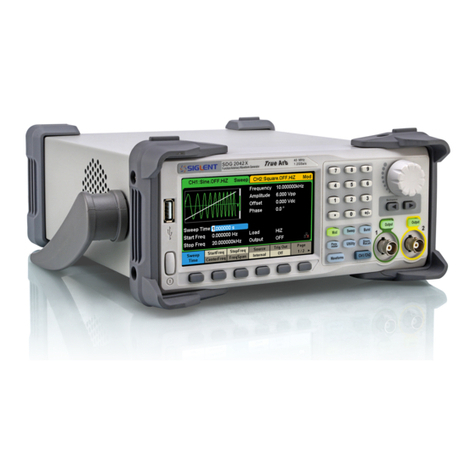
SIGLENT
SIGLENT SDG2000X Series Service manual

ABB
ABB TRIO-5.8-TL-OUTD-S product manual

Mitsubishi Electric
Mitsubishi Electric FR-E720-0.4K instruction manual
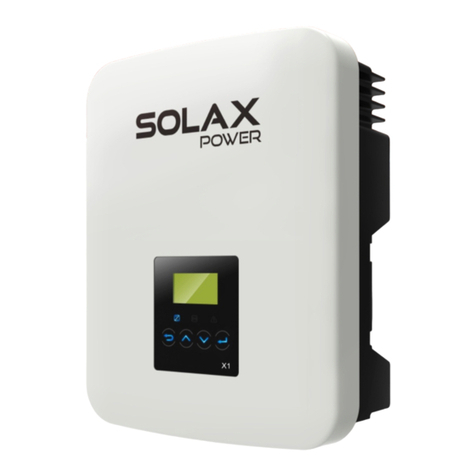
SolaX Power
SolaX Power X1 Series user manual
Silicon Graphics
Silicon Graphics SG1 user manual
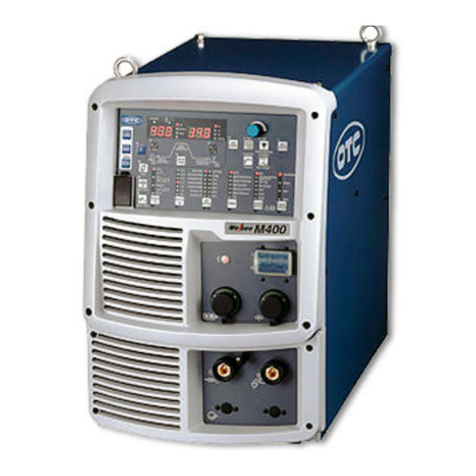
Daihen
Daihen OTC WB-M400 owner's manual

Rohde & Schwarz
Rohde & Schwarz AREG100A Getting started
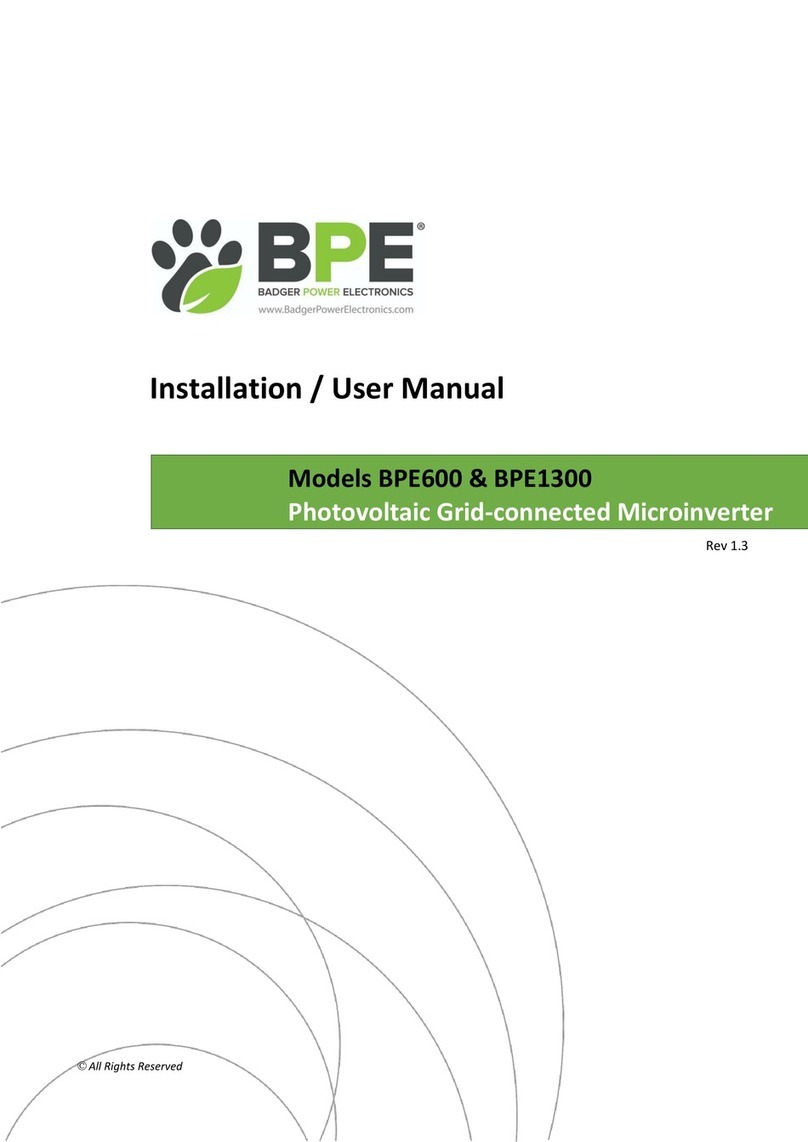
Badger Power Electronics
Badger Power Electronics BPE600 Installation & user manual

Westerbeke
Westerbeke WMD 8 specification

Victron energy
Victron energy Phoenix 12/1600 manual
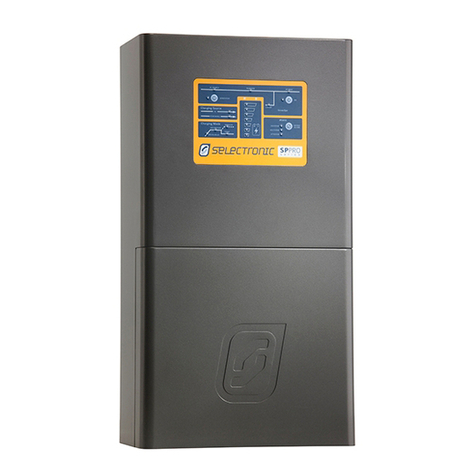
Selectronic
Selectronic SP PRO Installation notes




